Assessing Trade-Offs between Agricultural Productivity and Ecosystem Functions: A Review of Science-Based Tools?
Abstract
:1. Introduction
2. Materials and Methods
2.1. Design of the Review and Search Strategy
2.2. Screening Process
3. Results
3.1. Overview of Results
3.2. Practices
3.3. Ecosystem Functions and Services
3.4. Models for Trade-Off Analysis
3.5. Practical Tools for Trade-Off Analysis
- do not require special equipment or machinery,
- do not require expertise skills such as computer programming, GIS, or sophisticated economic analysis,
- produce information that can be understood and interpreted by practitioners and farmers and that can support a decision-making process, or
- are available to practitioners, farmers/groups of farmers, and the agricultural extension service or equivalent can help in adapting the tools and making them available.
3.6. Practical Tools of Relevance
| Name of Tool | Ecosystem Service(s) Targeted | Measure of Agricultural Productivity | Recommended Area of Application | Advantages | Disadvantages |
|---|---|---|---|---|---|
| Water Footprint approach in data-scarce regions van der Laan et al., 2021 [83] | Water provision—it divides water consumption into blue water (water from rivers, dams and underground sources) and green water (rainfall stored in the soil and available for vegetation growth) | Modelled water productivity per m3 in terms of monetary value and labor opportunities for selected crops | Agricultural basins and catchments in water scarce areas—focuses on water productivity |
|
|
| Healthy Farm Index (HFI) (Quinn et al., 2012 [84]) |
| Yield averages of selected common regional crops (e.g., maize, soybean, wheat) based on farm questionnaire | Farmland with e.g., maize, soybean, wheat |
|
|
| WET-Ecoservices (Rebelo et al., 2019 [85]; Kotze et al., 2007 [86])) |
| Scoring of the 15 ES are compared for different types of land use, including agricultural areas thereby showing trade-offs between ES and food production. | Catchments and landscapes where agriculture is replacing wetlands |
|
|
| Role-Playing Games (RPG) |
| Participatory simulation of land use change and impacts on livelihoods (cropping, livestock and collection of NTFPs) and ES based on agreed scores. | Complex mosaic landscapes—examples from farmland in France and slash-and-burn agriculture in Asia |
|
|
| SHARP—Self-evaluation and holistic assessment of climate resilience of farmers and pastoralists |
| Participatory self-assessment survey and ranking to inform and guide farmers’ practices. | Farmland and pastoral land |
|
|
| TESSA—Tool kit for Ecosystem Service Site-based Assessment |
| Site-based assessment of agricultural productivity translated into a monetary value, based on primary data collection and stakeholder consultations | Farmland and protected/conserved Land |
|
|
| ROAM—Restoration Opportunities Assessment Methodology |
| ES trade-offs with agricultural productivity are only indirectly assessed through stakeholder prioritization of restoration options | Forest and mosaic landscapes |
|
|
4. Discussion
5. Conclusions
- Provisioning ecosystem services related to water and food production are most commonly studied in articles on trade-offs between agricultural productivity and ecosystems functions. Although many studies were global in scope, the approach to analyzing and assessing trade-offs appears to vary geographically, with a stronger focus on ecosystem services in Europe and China, including an extensive use of models in China, while a focus on practices to increase yields was most common in Africa. Improved interregional knowledge exchange and collaboration is therefore recommended to advance the analysis of trade-offs between agricultural productivity and ecosystem functions and services.
- Many tools focus on just one or a bundle of ecosystem services, such as water-related ES, biodiversity and climate regulation, and are designed for different types of land use and ecosystems and are applicable at different scales. Therefore, tools need to be selected, adapted and further developed, based on the landscape and socio-economic context, priority ES and site characteristics.
- Practical tools for trade-off analysis are primarily found in the grey literature and have been developed and applied by development organizations with support from science. Closer collaboration between practitioners, development organizations, NGOs and scientists is suggested to foster co-development of tools useful to assess trade-offs and for identifying sustainable strategies for closing the yield gap, increasing productivity and for balancing ecosystem services included in the SDG framework.
- One way forward could be to establish innovation platforms that link different actors and organizations—practitioners, scientists, development organizations and extensionists, as has been exemplified from our research in Burkina Faso. In these settings, testing and combining tools such as ROAM and TESSA to restore parklands and to consider trade-offs between productivity and ecosystem functions could prove fruitful.
Supplementary Materials
Author Contributions
Funding
Data Availability Statement
Conflicts of Interest
References
- Fischer, R.A.; Connor, D.J. Issues for cropping and agricultural science in the next 20 years. Field Crops Res. 2018, 222, 121–142. [Google Scholar] [CrossRef]
- Bommarco, R.; Vico, G.; Hallin, S. Exploiting ecosystem services in agriculture for increased food security. Glob. Food Sec. 2018, 17, 57–63. [Google Scholar] [CrossRef]
- Millennium Ecosystem Assessment. Ecosystems and Human Well-Being: Current State and Trends: Findings of the Conditions and Trends Working Group; Hassan, R., Scholes, R., Ash, N., Eds.; Island Press: Washington, DC, USA, 2005. [Google Scholar]
- Rong, L.; Gong, K.; Duan, F.; Li, S.; Zhao, M.; He, J.; Zhou, W.-B.; Yu, Q. Yield gap and resource utilization efficiency of three major food crops in the world—A review. J. Integr. Agric. 2021, 20, 349–362. [Google Scholar] [CrossRef]
- Nkonya, E.; Anderson, W.; Kato, E.; Koo, J.; Mirzabaev, A.; von Braun, J.; Meyer, S. Global Cost of Land Degradation; Nkonya, E., Mirzabaev, A., von Braun, J., Eds.; Springer: Berlin/Heidelberg, Germany, 2015. [Google Scholar]
- Simelton, E.; Ostwald, M. Multifunctional Land Uses in Africa; Routledge: Oxon, UK, 2020; Available online: www.routledge.com/books/series/ECEFA/ (accessed on 21 October 2021).
- Hirwa, H.; Zhang, Q.; Qiao, Y.; Peng, Y.; Leng, P.; Tian, C.; Khasanov, S.; Li, F.; Kayiranga, A.; Muhirwa, F.; et al. Insights on Water and Climate Change in the Greater Horn of Africa: Connecting Virtual Water and Water-Energy-Food-Biodiversity-Health Nexus. Sustainability 2021, 13, 6483. [Google Scholar] [CrossRef]
- Subedi, R.; Karki, M.; Panday, D. Food System and Water–Energy–Biodiversity Nexus in Nepal: A Review. Agronomy 2020, 10, 1129. [Google Scholar] [CrossRef]
- Van Vuuren, D.P.; Bijl, D.L.; Bogaart, P.; Stehfest, E.; Biemans, H.; Dekker, S.C.; Doelman, J.C.; Gernaat, D.E.; Harmsen, M. Integrated scenarios to support analysis of the food–energy–water nexus. Nat. Sustain. 2019, 2, 1132–1141. [Google Scholar] [CrossRef]
- Best, A.; Langsdorf, S.; Duin, L.; Araujo, A. Assessment of Resource Nexus-Related Challenges and Opportunities in the Context of the European Green Deal. Background Report for the EEA Briefing “Applying a ‘Resource nexus’ Lens to Policy: Opportunities for Increasing Coherence”; Coherent Digital, LLC: Berlin, Germany, 2021. [Google Scholar]
- OECD. Towards Sustainable Land Use: Aligning Biodiversity, Climate and Food Policies; OECD Publishing: Paris, France, 2020. [Google Scholar]
- Pradhan, P.; Costa, L.; Rybski, D.; Lucht, W.; Kropp, J.P. A Systematic Study of Sustainable Development Goal (SDG) Interactions. Earths Future 2017, 5, 1169–1179. [Google Scholar] [CrossRef] [Green Version]
- Sentelhas, P.C.; Battisti, R.; Câmara, G.M.S.; Farias, J.R.B.; Hampf, A.C.; Nendel, C. The soybean yield gap in Brazil—Magnitude, causes and possible solutions for sustainable production. J. Agric. Sci. 2015, 153, 1394–1411. [Google Scholar] [CrossRef] [Green Version]
- Silva, J.V.; Ramisch, J.J. Whose gap counts? The role of yield gap analysis within a development-oriented agronomy. Exp. Agric. 2019, 55, 311–338. [Google Scholar] [CrossRef] [Green Version]
- Shamseer, L.; Moher, D.; Clarke, M.; Ghersi, D.; Liberati, A.; Petticrew, M.; Shekelle, P.; Stewart, L.A.; PRISMA-P Group. Preferred reporting items for systematic review and meta-analysis protocols (prisma-p) 2015, Elaboration and explanation. BMJ 2015, 349, g7647. [Google Scholar] [CrossRef] [Green Version]
- Ouzzani, M.; Hammady, H.; Fedorowicz, Z.; Elmagarmid, A. Rayyan—A web and mobile app for systematic reviews. Syst. Rev. 2016, 5, 210. [Google Scholar] [CrossRef] [PubMed] [Green Version]
- Tsafnat, G.; Glasziou, P.; Choong, M.K.; Dunn, A.; Galgani, F.; Coiera, E. Systematic review automation technologies. Syst. Rev. 2014, 3, 74. [Google Scholar] [CrossRef] [Green Version]
- Bekchanov, M.; Mirzabaev, A. Circular economy of composting in Sri Lanka: Opportunities and challenges for reducing waste related pollution and improving soil health. J. Clean. Prod. 2018, 202, 1107–1119. [Google Scholar] [CrossRef]
- Lauriano-Barajas, J.; Vega-Frutis, R. Infectivity and effectivity of commercial and native arbuscular mycorrhizal biofertilizers in seedlings of maize (Zea mays). Bot. Sci. 2018, 96, 395–404. [Google Scholar] [CrossRef] [Green Version]
- Shi, W.; Zhao, H.Y.; Chen, Y.; Wang, J.S.; Han, B.; Li, C.P.; Lu, J.Y.; Zhang, L.M. Organic manure rather than phosphorus fertilization primarily determined asymbiotic nitrogen fixation rate and the stability of diazotrophic community in an upland red soil. Agric. Ecosyst. Environ. 2021, 319, 107535. [Google Scholar] [CrossRef]
- Stavi, I. Biochar use in forestry and tree-based agro-ecosystems for increasing climate change mitigation and adaptation. Int. J. Sustain. Dev. World Ecol. 2013, 20, 166–181. [Google Scholar] [CrossRef]
- Tisserant, A.; Cherubini, F. Potentials, limitations, co-benefits, and trade-offs of biochar applications to soils for climate change mitigation. Land 2019, 8, 179. [Google Scholar] [CrossRef] [Green Version]
- Zhang, X.; Fang, Q.; Zhang, T.; Ma, W.; Velthof, G.L.; Hou, Y.; Oenema, O.; Zhang, F. Benefits and trade-offs of replacing synthetic fertilizers by animal manures in crop production in China: A meta-analysis. Glob. Change Biol. 2020, 26, 888–900. [Google Scholar] [CrossRef]
- Dixon, J.L.; Stringer, L.C.; Challinor, A.J. Farming system evolution and adaptive capacity: Insights for adaptation support. Resources 2014, 3, 182–214. [Google Scholar] [CrossRef] [Green Version]
- Iverson, A.L.; Marín, L.E.; Ennis, K.K.; Gonthier, D.J.; Connor-Barrie, B.T.; Remfert, J.L.; Cardinale, B.J.; Perfecto, I. Do polycultures promote win-wins or trade-offs in agricultural ecosystem services? A meta-analysis. J. Appl. Ecol. 2014, 51, 1593–1602. [Google Scholar] [CrossRef]
- Leippert, F.; Darmaun, M.; Bernoux, M.; Mpheshea, M. The Potential of Agroecology to Build Climate-Resilient Livelihoods and Food Systems; Food and Agriculture Organization of the United Nations FAO and Biovision: Rome, Italy, 2020. [Google Scholar]
- Nassary, E.K.; Baijukya, F.; Ndakidemi, P.A. Sustainable intensification of grain legumes optimizes food security on smallholder farms in Sub-Saharan Africa-A review. Int. J. Agric. Biol. 2020, 23, 25–41. [Google Scholar]
- Rasul, G. Ecosystem services and agricultural land-use practices: A case study of the Chittagong Hill Tracts of Bangladesh. Sustain. Sci. Pract. Policy 2009, 5, 15–27. [Google Scholar] [CrossRef]
- Lorenz, K. Organic urban agriculture. Soil Sci. 2015, 180, 146–153. [Google Scholar] [CrossRef] [Green Version]
- Sandhu, H.S.; Wratten, S.D.; Cullen, R.; Case, B. The future of farming: The value of ecosystem services in conventional and organic arable land. An experimental approach. Ecol. Econ. 2008, 64, 835–848. [Google Scholar] [CrossRef]
- Smith, O.M.; Cohen, A.L.; Rieser, C.J.; Davis, A.G.; Taylor, J.M.; Adesanya, A.W.; Jones, M.S.; Meier, A.R.; Reganold, J.P.; Orpet, R.J.; et al. Organic Farming Provides Reliable Environmental Benefits but Increases Variability in Crop Yields: A Global Meta-Analysis. Front. Sustain. Food Syst. 2019, 3, 82. [Google Scholar] [CrossRef] [Green Version]
- An, N.; Fan, M.; Zhang, F.; Christie, P.; Yang, J.; Huang, J.; Guo, S.; Shi, X.; Tang, Q.; Peng, J.; et al. Exploiting co-benefits of increased rice production and reduced greenhouse gas emission through optimized crop and soil management. PLoS ONE 2015, 10, e0140023. [Google Scholar] [CrossRef] [PubMed]
- Pauli, N.; Donough, C.; Oberthür, T.; Cock, J.; Verdooren, R.; Rahmadsyah; Abdurrohim, G.; Indrasuara, K.; Lubis, A.; Dolong, T.; et al. Changes in soil quality indicators under oil palm plantations following application of “best management practices” in a four-year field trial. Agric. Ecosyst. Environ. 2014, 195, 98–111. [Google Scholar] [CrossRef]
- Piñeiro, V.; Arias, J.; Dürr, J.; Elverdin, P.; Ibáñez, A.M.; Kinengyere, A.; Opazo, C.M.; Owoo, N.; Page, J.R.; Prager, S.D.; et al. A scoping review on incentives for adoption of sustainable agricultural practices and their outcomes. Nat. Sustain. 2020, 3, 809–820. [Google Scholar] [CrossRef]
- Kirkegaard, J.A.; Conyers, M.K.; Hunt, J.R.; Kirkby, C.A.; Watt, M.; Rebetzke, G.J. Sense and nonsense in conservation agriculture: Principles, pragmatism and productivity in Australian mixed farming systems. Agric. Ecosyst. Environ. 2014, 187, 133–145. [Google Scholar] [CrossRef]
- Ngigi, S.N.; Rockström, J.; Savenije, H.H.G. Assessment of rainwater retention in agricultural land and crop yield increase due to conservation tillage in Ewaso Ng’iro river basin, Kenya. Phys. Chem. Earth 2006, 31, 910–918. [Google Scholar] [CrossRef]
- Speratti, A.; Turmel, M.S.; Calegari, A.; Araujo, C.F.; Violic, A.; Wall, P.; Govaerts, B. Conservation agriculture in Latin America. In Conservation Agriculture; Springer International Publishing: Cham, Switzerland, 2015; pp. 391–415. [Google Scholar]
- Albert, C.; Galler, C.; Hermes, J.; Neuendorf, F.; Von Haaren, C.; Lovett, A. Applying ecosystem services indicators in landscape planning and management: The ES-in-Planning framework. Ecol. Indic. 2016, 61, 100–113. [Google Scholar] [CrossRef]
- Cao, Y.; Li, G.; Tian, Y.; Fang, X.; Li, Y.; Tan, Y. Linking ecosystem services trade-offs, bundles and hotspot identification with cropland management in the coastal Hangzhou Bay area of China. Land Use Policy 2020, 97, 104689. [Google Scholar] [CrossRef]
- Di Maggio, R.; Campobello, D.; Tavecchia, G.; Sarà, M. Habitat- and density-dependent demography of a colonial raptor in Mediterranean agro-ecosystems. Biol. Conserv. 2016, 193, 116–123. [Google Scholar] [CrossRef] [Green Version]
- Marinaro, S.; Grau, H.R.; Gasparri, N.I.; Kuemmerle, T.; Baumann, M. Differences in production, carbon stocks and biodiversity outcomes of land tenure regimes in the Argentine Dry Chaco. Environ. Res. Lett. 2017, 12, 045003. [Google Scholar] [CrossRef]
- D’Ottavio, P.; Francioni, M.; Trozzo, L.; Sedić, E.; Budimir, K.; Avanzolini, P.; Trombetta, M.F.; Porqueddu, C.; Santilocchi, R.; Toderi, M. Trends and approaches in the analysis of ecosystem services provided by grazing systems: A review. Grass Forage Sci. 2017, 73, 15–25. [Google Scholar] [CrossRef]
- Hu, Y.; Peng, J.; Liu, Y.; Tian, L. Integrating ecosystem services trade-offs with paddy land-to-dry land decisions: A scenario approach in Erhai Lake Basin, southwest China. Sci. Total Environ. 2018, 625, 849–860. [Google Scholar] [CrossRef]
- Luo, Y.; Lü, Y.; Fu, B.; Zhang, Q.; Li, T.; Hu, W.; Comber, A. Half century change of interactions among ecosystem services driven by ecological restoration: Quantification and policy implications at a watershed scale in the Chinese Loess Plateau. Sci. Total Environ. 2019, 651, 2546–2557. [Google Scholar] [CrossRef] [PubMed] [Green Version]
- Manik, S.M.N.; Pengilley, G.; Dean, G.; Field, B.; Shabala, S.; Zhou, M. Soil and crop management practices to minimize the impact of waterlogging on crop productivity. Front. Plant Sci. 2019, 10, 140. [Google Scholar] [CrossRef] [Green Version]
- Qiu, M.; Van de Voorde, T.; Li, T.; Yuan, C.; Yin, G. Spatiotemporal variation of agroecosystem service trade-offs and its driving factors across different climate zones. Ecol. Indic. 2021, 130, 108154. [Google Scholar] [CrossRef]
- Weninger, T.; Scheper, S.; Lackóová, L.; Kitzler, B.; Gartner, K.; King, N.W.; Cornelis, W.M.; Strauss, P.; Michel, K. Ecosystem services of tree windbreaks in rural landscapes—A systematic review. Environ. Res. Lett. 2021, 16, 103002. [Google Scholar] [CrossRef]
- Chen, T.; Feng, Z.; Zhao, H.; Wu, K. Identification of ecosystem service bundles and driving factors in Beijing and its surrounding areas. Sci. Total Environ. 2020, 711, 134687. [Google Scholar] [CrossRef]
- Coutinho, J.G.d.E.; Garibaldi, L.A.; Viana, B.F. The influence of local and landscape scale on single response traits in bees: A meta-analysis. Agric. Ecosyst. Environ. 2018, 256, 61–73. [Google Scholar] [CrossRef]
- Smith, F.P.; Gorddard, R.; House, A.P.N.; McIntyre, S.; Prober, S.M. Biodiversity and agriculture: Production frontiers as a framework for exploring trade-offs and evaluating policy. Environ. Sci. Policy 2012, 23, 85–94. [Google Scholar] [CrossRef]
- Gockowski, J.; Tchatat, M.; Jean-Paul, D.; Hietet, G.; Fouda, T. An empirical analysis of the biodiversity and economic returns to cocoa agroforests in southern cameroon. J. Sustain. For. 2010, 29, 638–670. [Google Scholar] [CrossRef]
- Lyu, R.; Clarke, K.C.; Zhang, J.; Feng, J.; Jia, X.; Li, J. Spatial correlations among ecosystem services and their socio-ecological driving factors: A case study in the city belt along the Yellow River in Ningxia, China. Appl. Geogr. 2019, 108, 64–73. [Google Scholar] [CrossRef] [Green Version]
- Malinga, R. Ecosystem Services in Agricultural Landscapes: A Study on Farming and Farmers in South Africa and Sweden. Ph.D. Thesis, Stockholm University, Stockholm, Sweden, 2016. [Google Scholar]
- Tallis, H.; Polasky, S. Mapping and valuing ecosystem services as an approach for conservation and natural-resource management. Ann. N. Y. Acad. Sci. 2009, 1162, 265–283. [Google Scholar] [CrossRef]
- Balbi, S.; del Prado, A.; Gallejones, P.; Geevan, C.P.; Pardo, G.; Pérez-Miñana, E.; Manrique, R.; Hernandez-Santiago, C.; Villa, F. Modeling trade-offs among ecosystem services in agricultural production systems. Environ. Model. Softw. 2015, 72, 314–326. [Google Scholar] [CrossRef] [Green Version]
- Hou, Y.; Zhao, W.; Liu, Y.; Yang, S.; Hu, X.; Cherubini, F. Relationships of multiple landscape services and their influencing factors on the Qinghai–Tibet Plateau. Landsc. Ecol. 2021, 36, 1987–2005. [Google Scholar] [CrossRef]
- Li, P.; Agusdinata, D.B.; Suditha, P.H.; Zhang, Y. Ecosystem services and trade-offs: Implications for land dynamics and sustainable livelihoods in Northern Lombok, Indonesia. Environ. Dev. Sustain. 2021, 23, 4321–4341. [Google Scholar] [CrossRef]
- Dai, E.; Yin, L.; Wang, Y.; Ma, L.; Tong, M. Quantitative assessment of the relative impacts of land use and climate change on the key ecosystem services in the Hengduan Mountain Region, China. Sustainability 2020, 12, 4100. [Google Scholar] [CrossRef]
- Feng, Q.; Zhao, W.; Hu, X.; Liu, Y.; Daryanto, S.; Cherubini, F. Trading-off ecosystem services for better ecological restoration: A case study in the Loess Plateau of China. J. Clean. Prod. 2020, 257, 120469. [Google Scholar] [CrossRef]
- King, E.; Cavender-Bares, J.; Balvanera, P.; Mwampamba, T.H.; Polasky, S. Trade-offs in ecosystem services and varying stakeholder preferences: Evaluating conflicts, obstacles, and opportunities. Ecol. Soc. 2015, 20, 25. [Google Scholar] [CrossRef] [Green Version]
- Crossman, N.D.; Burkhard, B.; Nedkov, S.; Willemen, L.; Petz, K.; Palomo, I.; Drakou, E.G.; Martin-Lopez, B.; McPhearson, T.; Boyanova, K.; et al. A blueprint for mapping and modelling ecosystem services. Ecosyst. Serv. 2013, 4, 4–14. [Google Scholar] [CrossRef]
- Shepherd, K.D.; Shepherd, G.; Walsh, M.G. Land health surveillance and response: A framework for evidence-informed land management. Agric. Syst. 2015, 132, 93–106. [Google Scholar] [CrossRef]
- Kanter, D.R.; Musumba, M.; Wood, S.L.R.; Palm, C.; Antle, J.; Balvanera, P.; Dale, V.H.; Havlik, P.; Kline, K.L.; Scholes, R.J.; et al. Evaluating agricultural trade-offs in the age of sustainable development. Agric. Syst. 2018, 163, 73–88. [Google Scholar] [CrossRef]
- Zhen, L.; Routray, J.K. Operational Indicators for Measuring Agricultural Sustainability in Developing Countries. Environ. Manag. 2003, 32, 34–46. [Google Scholar] [CrossRef] [PubMed] [Green Version]
- Sheppard, D.J.; Moehrenschlager, A.; Mcpherson, J.M.; Mason, J.J. Ten years of adaptive community-governed conservation: Evaluating biodiversity protection and poverty alleviation in a West African hippopotamus reserve. Environ. Conserv. 2010, 37, 270–282. [Google Scholar] [CrossRef]
- Takahashi, T.; Harris, P.; Blackwell, M.S.A.; Cardenas, L.M.; Collins, A.L.; Dungait, J.A.J.; Hawkins, J.; Misselbrook, T.; McAuliffe, G.; McFadzean, J.; et al. Roles of instrumented farm-scale trials in trade-off assessments of pasture-based ruminant production systems. Animal 2018, 12, 1766–1776. [Google Scholar] [CrossRef] [Green Version]
- Groot, J.C.J.; Rossing, W.A.J.; Stobbelaar, D.J.; Renting, H.; Van Ittersum, M.K. Supporting discussions on land use: A design instrument that integrates nature conservation, economic performance and landscape quality in agricultural areas. In Changing European Farming Systems for a Better Future: New Visions for Rural Areas; Langeveld, H., Röling, N., Eds.; Wageningen Academic Publishers: Wageningen, The Netherlands, 2006; Available online: https://www.researchgate.net/publication/40114671 (accessed on 21 October 2021).
- Trodahl, M.I.; Jackson, B.M.; Deslippe, J.R.; Metherell, A.K. Investigating trade-offs between water quality and agricultural productivity using the Land Utilisation and Capability Indicator (LUCI)–A New Zealand application. Ecosyst. Serv. 2017, 26, 388–399. [Google Scholar] [CrossRef]
- Robinson, B.E.; Zheng, H.; Peng, W. Disaggregating livelihood dependence on ecosystem services to inform land management. Ecosyst. Serv. 2019, 36, 100902. [Google Scholar] [CrossRef]
- Ng’ang’a, S.K.; Miller, V.; Girvetz, E. Is investment in Climate-Smart-agricultural practices the option for the future? Cost and benefit analysis evidence from Ghana. Heliyon 2021, 7, e06653. [Google Scholar] [CrossRef]
- Tenge, A.J.; Okoba, B.O.; Sterk, G. Participatory soil and water conservation planning using a financial analysis tool in the West Usambara highlands of Tanzania. Land Degrad. Dev. 2007, 18, 321–337. [Google Scholar] [CrossRef]
- Hajkowicz, S.; Collins, K.; Cattaneo, A. Review of agri-environment indexes and stewardship payments. Environ. Manag. 2009, 43, 221–236. [Google Scholar] [CrossRef]
- Kearney, S.P.; Fonte, S.J.; García, E.; Siles, P.; Chan, K.M.A.; Smukler, S.M. Evaluating ecosystem service trade-offs and synergies from slash-and-mulch agroforestry systems in El Salvador. Ecol. Indic. 2019, 105, 264–278. [Google Scholar] [CrossRef]
- Scholz, M.; Uzomah, V.C.; Almuktar, S.A.; Radet-Taligot, J. Selecting sustainable drainage structures based on ecosystem service variables estimated by different stakeholder groups. Water 2013, 5, 1741–1759. [Google Scholar] [CrossRef] [Green Version]
- FAO. Mainstreaming Ecosystem Services and Biodiversity in Agricultural Production and Management in East Africa: Technical Guidance Document. 2016. Available online: www.fao.org/publications (accessed on 21 October 2021).
- Ranganathan, J.; Raudsepp-Hearne, C.; Lucas, N.; Irwin, F.; Zurek, M.; Bennett, K.; Ash, N.; West, P. Ecosystem Services a Guide for Decision Makers the Decision: A Fictional Story about a Community Facing Ecosystem Change Plus; World Resources Institute: Washington, DC, USA, 2008. [Google Scholar]
- Sanon, S.; Hein, T.; Douven, W.; Winkler, P. Quantifying ecosystem service trade-offs: The case of an urban floodplain in Vienna, Austria. J. Environ. Manag. 2012, 111, 159–172. [Google Scholar] [CrossRef] [PubMed]
- Schuler, M.S.; Cañedo-Argüelles, M.; Hintz, W.D.; Dyack, B.; Birk, S.; Relyea, R.A. Regulations are needed to protect freshwater ecosystems from salinization. Philos. Trans. R. Soc. B Biol. Sci. 2019, 374, 20180019. [Google Scholar] [CrossRef] [Green Version]
- Xue, H.; Li, S.; Chang, J. Combining ecosystem service relationships and DPSIR framework to manage multiple ecosystem services. Environ. Monit. Assess. 2015, 187, 117. [Google Scholar] [CrossRef]
- Sil, Â.; Rodrigues, A.P.; Carvalho-Santos, C.; Nunes, J.P.; Honrado, J.; Alonso, J.; Marta-Pedroso, C.; Azevedo, J.C. Trade-offs and Synergies between Provisioning and Regulating Ecosystem Services in a Mountain Area in Portugal Affected by Landscape Change. Mt. Res. Dev. 2016, 36, 452–464. [Google Scholar] [CrossRef] [Green Version]
- Chennault, C.M. People in Ecosystems/Watershed Integration: Visualizing Ecosystem Services Tradeoffs in Agricultural Landscapes. Ph.D. Thesis, Iowa State University, Ames, IA, USA, 2014. [Google Scholar]
- le Roux, B.; van der Laan, M.; Vahrmeijer, T.; Bristow, K.L.; Annandale, J.G. Establishing and testing a catchment water footprint framework to inform sustainable irrigation water use for an aquifer under stress. Sci. Total Environ. 2017, 599–600, 1119–1129. [Google Scholar] [CrossRef] [PubMed]
- van der Laan, M.; Eckert, S.; da Silva, M.; Annandale, J. A water footprint approach to guide water resource management in data-scarce regions: A case study for the upper ewaso ng’iro basin, mount kenya. Water 2021, 47, 356–366. [Google Scholar] [CrossRef]
- Quinn, J.E.; Brandle, J.R.; Johnson, R.J. A farm-scale biodiversity and ecosystem services assessment tool: The healthy farm index. Int. J. Agric. Sustain. 2013, 11, 176–192. [Google Scholar] [CrossRef] [Green Version]
- Rebelo, A.J.; Morris, C.; Meire, P.; Esler, K.J. Ecosystem services provided by South African palmiet wetlands: A case for investment in strategic water source areas. Ecol. Indic. 2019, 101, 71–80. [Google Scholar] [CrossRef]
- Kotze, D.C.; Macfarlane, D.M.; Edwards, R.J.; Madikizela, B. Wet-ecoservices version 2, A revised ecosystem services assessment technique, and its application to selected wetland and riparian areas. Water 2020, 46, 679–688. [Google Scholar] [CrossRef]
- Hardy, P.Y.; Dray, A.; Cornioley, T.; David, M.; Sabatier, R.; Kernes, E.; Souchère, V. Public policy design: Assessing the potential of new collective Agri-Environmental Schemes in the Marais Poitevin wetland region using a participatory approach. Land Use Policy 2020, 97, 104724. [Google Scholar] [CrossRef]
- Castella, J.C.; Lestrelin, G. Exploring the environmental impact of agrarian changes in Southeast Asia through participatory evaluation of ecosystem services. Cah. Agric. 2021, 30, 3. [Google Scholar] [CrossRef]
- Girma, R.; Tengberg, A.; Zazu, C. Training Manual International Water Management Institute (IWMI) Participatory Land Use Planning; Stockholm International Water Institute and International Water Management Institute: Addis Ababa, Ethiopia, 2020. [Google Scholar]
- Choptiany, J.; Graub, B.; Phillips, S.; Colozza, D.; Dixon, J. Self-Evaluation and Holistic Assessment of Climate Resilience of Farmers and Pastoralists; FAO: Rome, Italy, 2015. [Google Scholar]
- FAO. The Self-Evaluation and Holistic Assessment of Climate Resilience for Farmers and Pastoralists (SHARP) Tool and the Enhanced Transparency Framework (ETF); FAO: Rome, Italy, 2021. [Google Scholar]
- Neugarten, R.A.; Langhammer, P.F.; Osipova, E.; Bagstad, K.J.; Bhagabati, N.; Butchart, S.H.M.; Dudley, N.; Elliott, V.; Gerber, L.R.; Arrellano, C.G.; et al. Tools for Measuring, Modelling, and Valuing Ecosystem Services Guidance for Key Biodiversity Areas, Natural World Heritage Sites, and Protected Areas; Best Practice Protected Area Guidelines Series No. 28 [Internet]; IUCN: Fontainebleau, France, 2018; Available online: www.iucn.org (accessed on 21 October 2021).
- Peh, K.S.-H.; Balmford, A.P.; Bradbury, R.B.; Brown, C.; Butchart, S.H.M.; Hughes, F.M.R.; MacDonald, M.A.; Stattersfield, A.J.; Thomas, D.H.L.; Trevelyan, R.J.; et al. Toolkit for Ecosystem Service SIte-based Assessment (TESSA). Version 2.0 [Internet]. Cambridge, UK. 2017. Available online: http://tessa.tools (accessed on 21 October 2021).
- Hanson, C.; Buckingham, K.; Dewitt, S.; Laestadius, L. The Restoration Diagnostic: A Method for Developing Forest Landscape Restoration Strategies by Rapidly Assessing the Status of Key Success Factors; Version 1.0; World Resources Institute: Washington, DC, USA, 2015. [Google Scholar]
- Jia, L.; Merten, J.; Burke, G.; Mumford, E.C. Application of Restoration Opportunities Assessment Methodology (ROAM) in Asia Summary of Findings from the First Asia Regional ROAM Learning Exchange; IUCN Asia Regional Office (ARO): Bangkok, Thailand, 2018. [Google Scholar]
- Jana, B.; Mandal, R.; Jayasankar, P. Wastewater Management Through Aquaculture; Jana, B.B., Mandal, R.N., Jayasankar, P., Eds.; Springer: Singapore, 2018. [Google Scholar]
- Holland, J.E.; Luck, G.W.; Max Finlayson, C. Threats to food production and water quality in the Murray-Darling Basin of Australia. Ecosyst. Serv. 2015, 12, 55–70. [Google Scholar] [CrossRef]
- Herrero, M.; Thornton, P.K.; Power, B.; Bogard, J.R.; Remans, R.; Fritz, S.; Gerber, J.S.; Nelson, G.; See, L.; Waha, K.; et al. Farming and the geography of nutrient production for human use: A transdisciplinary analysis. Lancet Planet. Health 2017, 1, e33–e42. [Google Scholar] [CrossRef] [PubMed] [Green Version]
- Fanzo, J. The role of farming and rural development as central to our diets. Physiol. Behav. 2018, 193, 291–297. [Google Scholar] [CrossRef]
- Dzanku, F.M.; Jirström, M.; Marstorp, H. Yield Gap-Based Poverty Gaps in Rural Sub-Saharan Africa. World Dev. 2015, 67, 336–362. [Google Scholar] [CrossRef]
- Cerda, R.; Deheuvels, O.; Calvache, D.; Niehaus, L.; Saenz, Y.; Kent, J.; Vilchez, S.; Villota, A.; Martinez, C.; Somarriba, E. Contribution of cocoa agroforestry systems to family income and domestic consumption: Looking toward intensification. Agrofor. Syst. 2014, 88, 957–981. [Google Scholar] [CrossRef]
- Röös, E.; Mie, A.; Wivstad, M.; Salomon, E.; Johansson, B.; Gunnarsson, S.; Wallenbeck, A.; Hoffmann, R.; Nilsson, U.; Sundberg, C.; et al. Risks and opportunities of increasing yields in organic farming. A review. Agron Sustain Dev. 2018, 38, 14. [Google Scholar] [CrossRef] [Green Version]
- Brady, M.; Sahrbacher, C.; Kellermann, K.; Happe, K. An agent-based approach to modeling impacts of agricultural policy on land use, biodiversity and ecosystem services. Landsc. Ecol. 2012, 27, 1363–1381. [Google Scholar] [CrossRef]
- Johnston, A.S.A.; Sibly, R.M.; Hodson, M.E.; Alvarez, T.; Thorbek, P. Effects of agricultural management practices on earthworm populations and crop yield: Validation and application of a mechanistic modelling approach. J. Appl. Ecol. 2015, 52, 1334–1342. [Google Scholar] [CrossRef] [Green Version]
- Alomia-Hinojosa, V.; Groot, J.C.J.; Andersson, J.A.; Speelman, E.N.; McDonald, A.J.; Tittonell, P. Assessing farmer perceptions on livestock intensification and associated trade-offs using fuzzy cognitive maps; a study in mixed farming systems in the mid-hills of Nepal. Syst. Res. Behav. Sci. 2023, 40, 146–158. [Google Scholar] [CrossRef]
- Ding, L.; Liao, Y.; Zhu, C.; Zheng, Q.; Wang, K. Multiscale Analysis of the Effects of Landscape Pattern on the Trade-Offs and Synergies of Ecosystem Services in Southern Zhejiang Province, China. Land 2023, 12, 949. [Google Scholar] [CrossRef]
- Arnott, J.C.; Neuenfeldt, R.J.; Lemos, M.C. Co-producing science for sustainability: Can funding change knowledge use? Glob. Environ. Change 2020, 60, 101979. [Google Scholar] [CrossRef]
- Pan, S.L.; Pee, L.G. Usable, in-use, and useful research: A 3U framework for demonstrating practice impact. Inf. Syst. J. 2020, 30, 403–426. [Google Scholar] [CrossRef]
- Cavender-Bares, J.; Polasky, S.; King, E.; Balvanera, P. A sustainability framework for assessing trade-offs in ecosystem services. Ecol. Soc. 2015, 20, 17. [Google Scholar] [CrossRef] [Green Version]
- Fraschini, F.; Hunt, A.; Zoboli, R. Decision tools for adaptation to climate change: Portfolio analysis of tea plantation investments in Rwanda. Ecol. Econ. 2022, 200, 107528. [Google Scholar] [CrossRef]
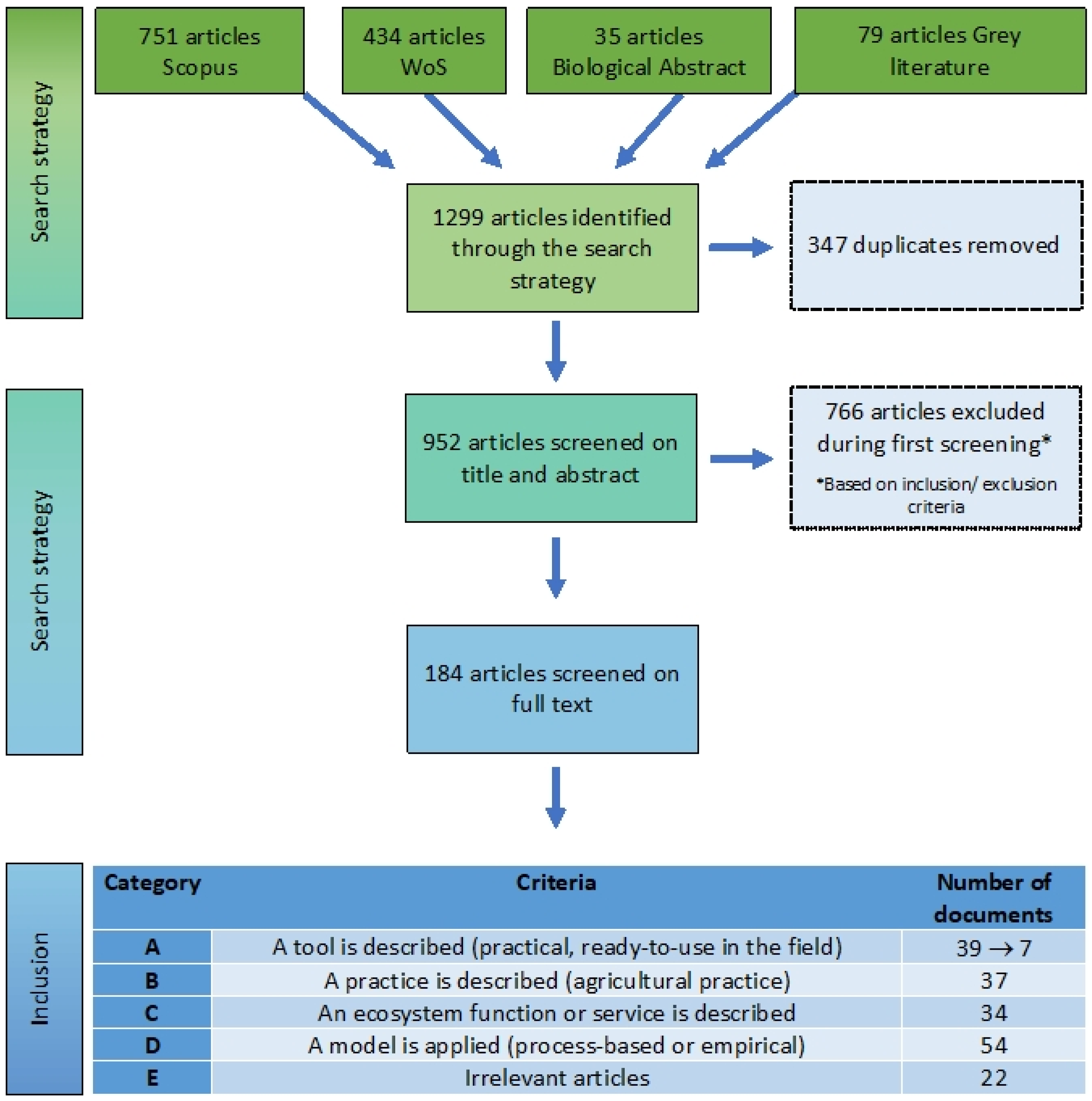
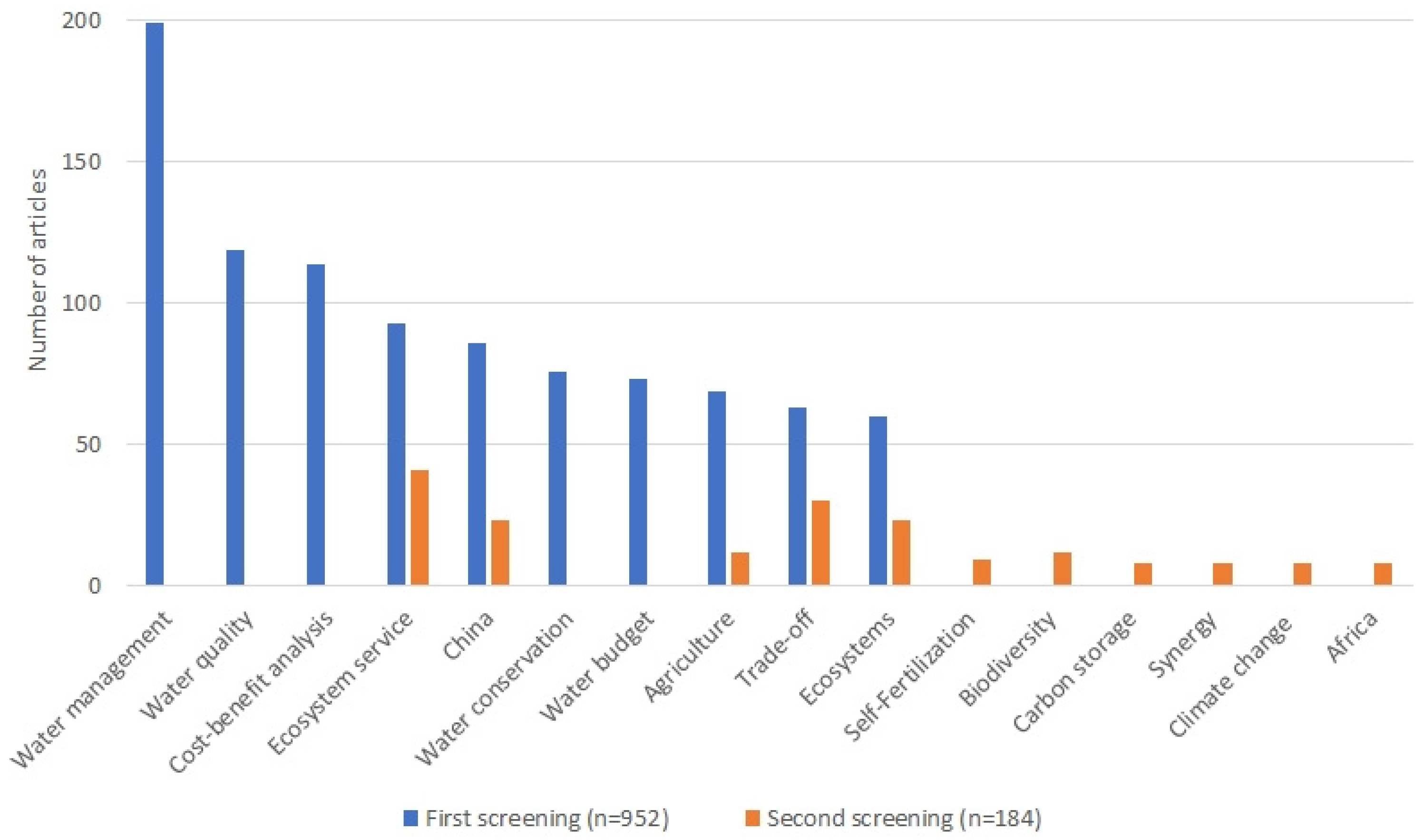
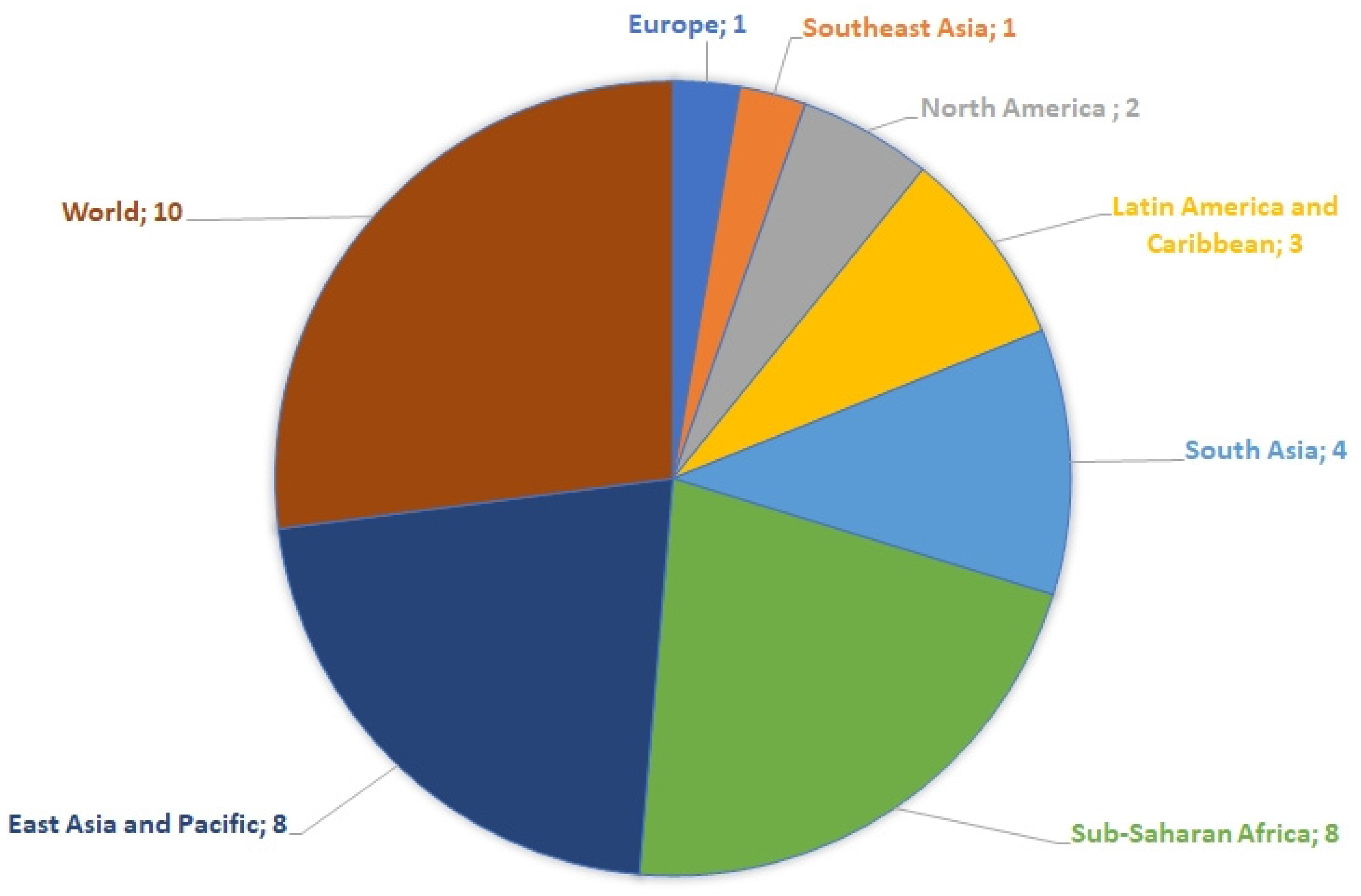

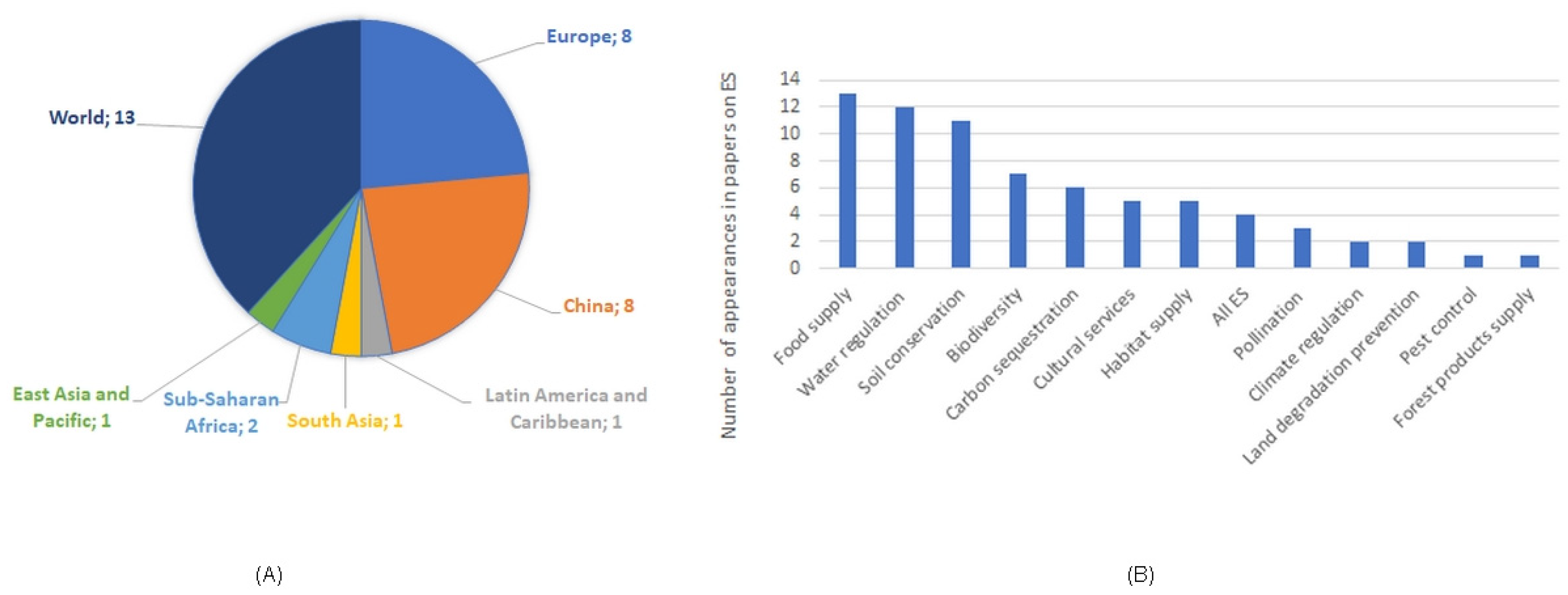
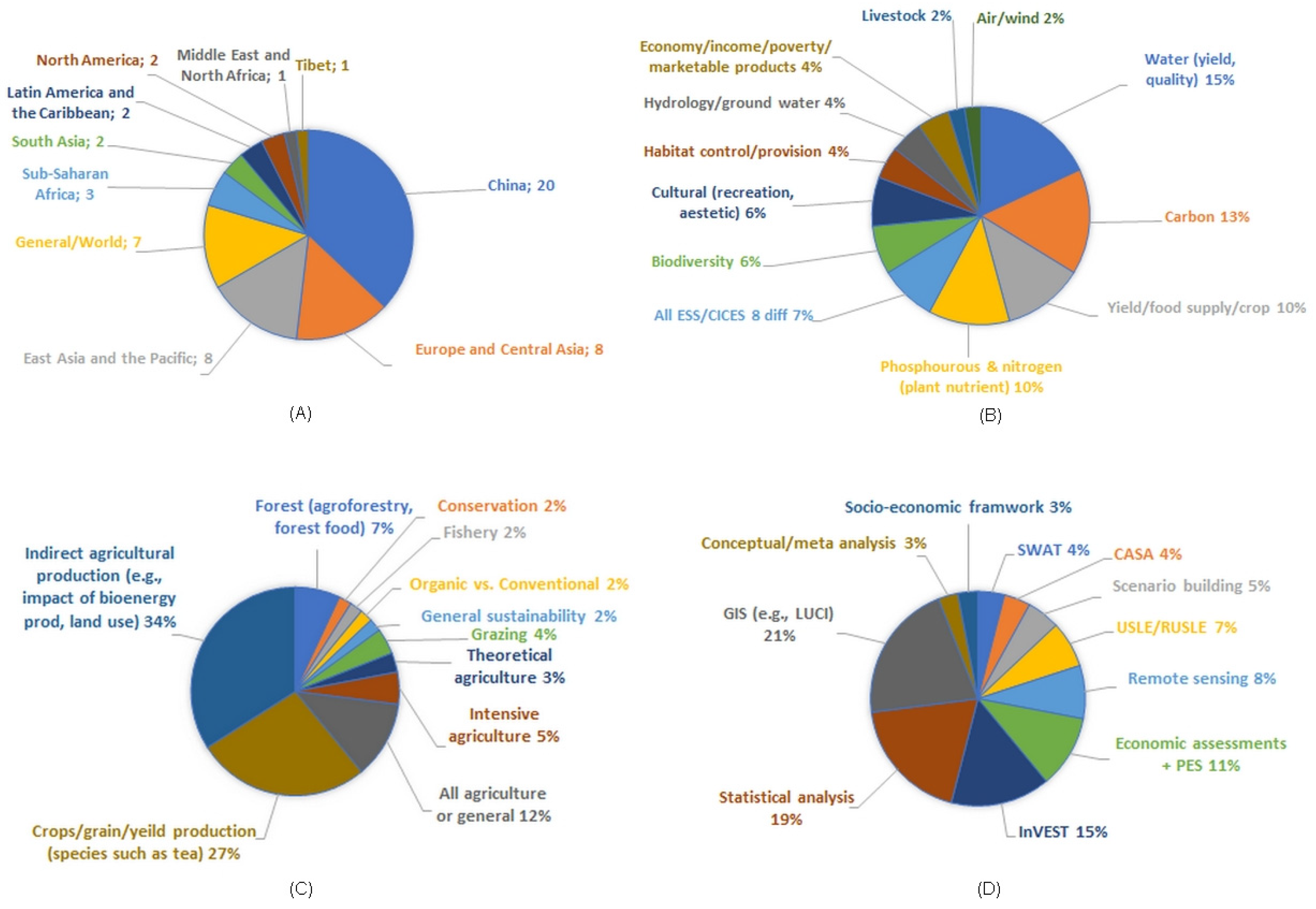
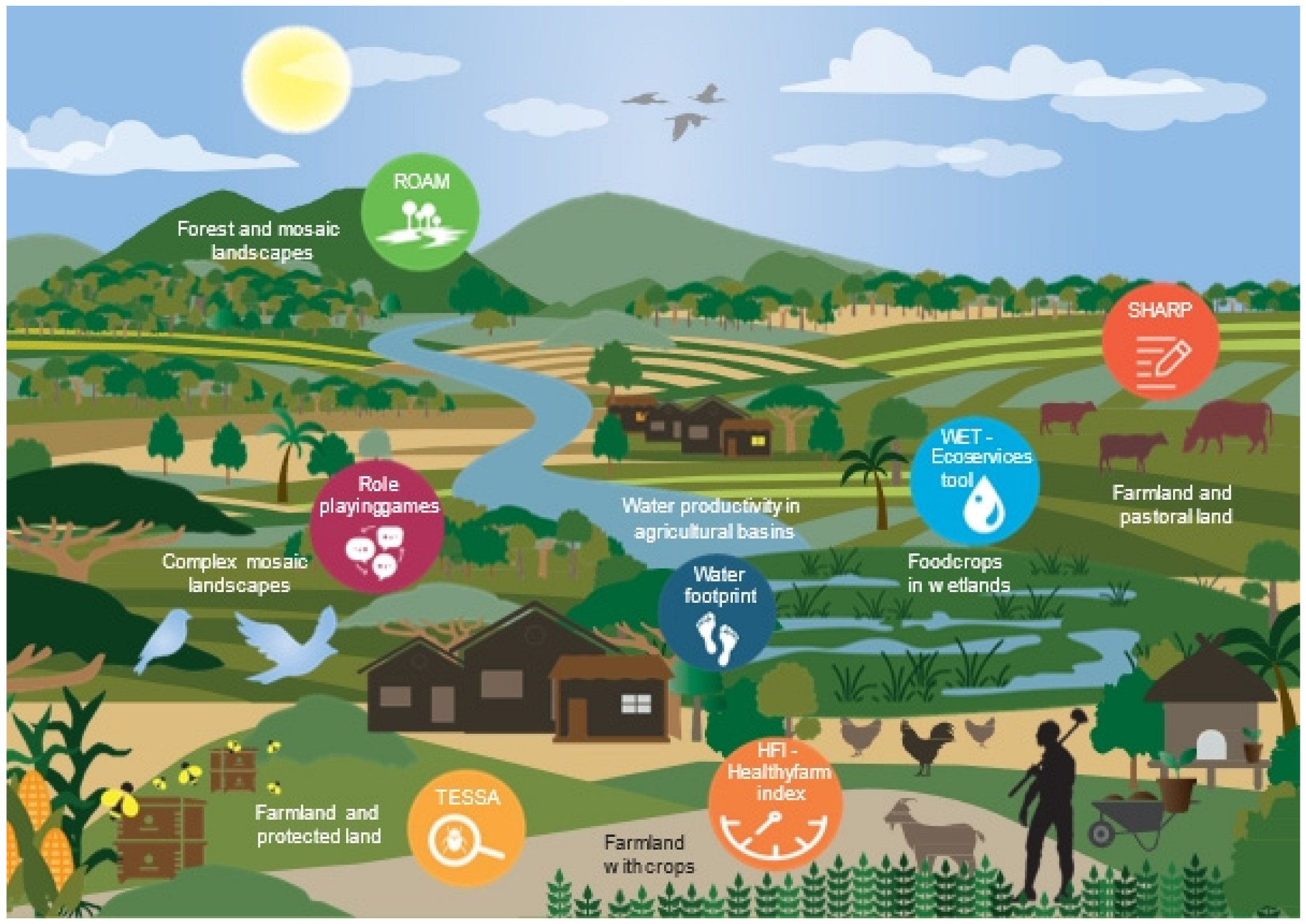
| Inclusion Criteria | Exclusion Criteria | |
|---|---|---|
| 1. | Language: articles in English and French | Articles not written in English or French |
| 2. | Time period: articles published from 1975 until Sept 2021 | Articles published before 1975 |
| 3. | Study design: practical on-the-ground studies and tools related to agriculture | Theoretical or modelling studies and tools; laboratory studies |
| 4. | Non-timber forest products (NTFPs), forest food | Wood, timber, pulp |
| 5. | Biodiversity | Genetic biodiversity |
| 6. | Animal production: fish, livestock, farming, aquaculture | Marine fisheries |
Disclaimer/Publisher’s Note: The statements, opinions and data contained in all publications are solely those of the individual author(s) and contributor(s) and not of MDPI and/or the editor(s). MDPI and/or the editor(s) disclaim responsibility for any injury to people or property resulting from any ideas, methods, instructions or products referred to in the content. |
© 2023 by the authors. Licensee MDPI, Basel, Switzerland. This article is an open access article distributed under the terms and conditions of the Creative Commons Attribution (CC BY) license (https://creativecommons.org/licenses/by/4.0/).
Share and Cite
Sanou, J.; Tengberg, A.; Bazié, H.R.; Mingasson, D.; Ostwald, M. Assessing Trade-Offs between Agricultural Productivity and Ecosystem Functions: A Review of Science-Based Tools? Land 2023, 12, 1329. https://doi.org/10.3390/land12071329
Sanou J, Tengberg A, Bazié HR, Mingasson D, Ostwald M. Assessing Trade-Offs between Agricultural Productivity and Ecosystem Functions: A Review of Science-Based Tools? Land. 2023; 12(7):1329. https://doi.org/10.3390/land12071329
Chicago/Turabian StyleSanou, Josias, Anna Tengberg, Hugues Roméo Bazié, David Mingasson, and Madelene Ostwald. 2023. "Assessing Trade-Offs between Agricultural Productivity and Ecosystem Functions: A Review of Science-Based Tools?" Land 12, no. 7: 1329. https://doi.org/10.3390/land12071329







